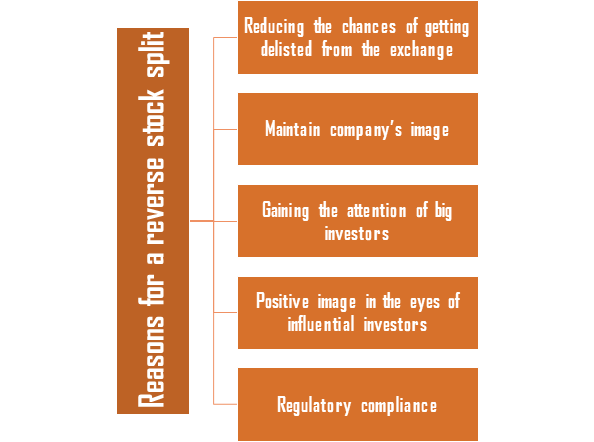What is a reverse stock split?
A corporate action in which the outstanding shares of the company are consolidated into fewer stocks, with the value of these stocks being proportionally higher, is known as the reverse stock split. Generally, consolidation of the shares in the open market shows that the company is in a situation of distress.
If a reverse stock split states that the action will be done in the form of 1-for-5, then it means that five shares will be consolidated into a single share. Other names for reverse stock splits are stock merge, stock consolidation and share rollback. It is the opposite of a stock split in which a single share is converted into many shares.
Summary
- A corporate action in which the outstanding shares of the company are consolidated into fewer stocks, however, the value of the stocks becomes proportionally higher in the process, is known as the reverse stock split.
- Consolidation of the shares in the open market shows that the company is in a situation of distress.
- If a reverse stock split states that the action will be done in the form of 1-for-5, then it means that 5 shares will be consolidated into a single share.
Frequently Asked Questions (FAQs)
What can be the reason for a reverse stock split?
There can be several reasons due to which a company chose to undertake a reverse stock split activity such as –
Reducing the chances of getting delisted from the exchange – Stock exchanges have specific rules in terms of the minimum share prices. For example, a stock exchange can delist a company if the share prices fall below $1. Moreover, delisting can take place if the share price remains below the required level for a certain period. Therefore, to avoid such circumstances reverse stock split is undertaken by the company because it is important to remain listed for attracting equity investment.
Once a company is delisted, then the company is forced to list itself on the pink sheet or over the counter bulletin boards. After getting into these markets, it becomes harder to maintain liquidity.
Maintain company’s image – When the stocks are trading at single-digit then it becomes difficult to attract investors as penny stocks are generally seen as a risky investment. A negative stigma is associated with the stocks whose value fall below $1. Therefore, to maintain the interest of the investors, reverse stock splits are employed.
Gaining the attention of big investors – Some mutual fund companies and institutional investors have the policy to invest in certain stocks whose value does not fall below the decided price. When a company is unable to generate investment from these investors then both reputation and liquidity are affected. Therefore, a reverse stock split is engineered by companies to keep the prices of their shares high.
Positive image in the eyes of influential investors – Market analysts play a crucial role in making the market or moving the funds within the market. Higher-priced stocks gain their attention and a positive image among market analysts is a plus sign for the company.
Regulatory compliance – In some countries, several shareholders are considered as a crucial factor in impacting the company’s regulation. By reducing the number of shareholdings, a company might aim to maintain their regulatory requirement. Even when a company wishes to become a private firm, it can also undertake a reverse stock split.

Image source: Copyright © 2021 Kalkine Media
What is the working of the Reverse Stocks Splits?
When a company announces a reverse stock splits, then it means that each outstanding share will be changed into a fraction of outstanding shares. For instance, XYZ company declared a reverse stock split of one for ten, that is, if a shareholder currently holds 10 shares, then it will be transformed into a single shareholding. Similarly, if a shareholder holds 10,000 shares, then the holdings will be converted into 1000 shares only.
A reverse stock split can be undertaken by the company with the aim to increase the current share prices on the exchange. For example, the reverse stock split is announced by a company because the management feels that the current trading price will not attract the investors to invest in the shares. In some cases, the reverse stock split is declared because the share price is not as per the minimum price requirements mentioned by the exchange. Small shareholders are affected by the reverse stock split, and they no longer can afford holdings in the company. With the fluctuation in the trading prices, investors might lose their whole investment.
Since the small shareholders are affected to large extent, therefore, Securities and Exchange Commission has the authority to interfere in the state corporate law, the company’s article of incorporation and corporate’s activity. In the terms of law, the authoritative body governs the activity of reverse stock split and ascertain whether the approval of shareholders is required or not.
A company can notify its shareholder regarding the reverse stock split through Forms 10-Q, 8-K or 10-K. A company need to file a proxy statement on Schedule 14A in case the company requires the shareholder’s approval for declaring the reverse stock split. In case the event results in the privatisation of the company, the company needs to file a statement on Schedule 13E-3.

Image source: © Bakhtiarzein | Megapixl.com
What is the criticism of reverse stock split?
A reverse stock split has gathered criticism because companies artificially leverage their share prices in such a manner that the risk is being borne by investors.
Those companies who adopt reverse stock split might attract a negative image in the stock market. Generally, a company conduct a reverse stock split when the share prices reach rock bottom or is in danger of getting delisted from the exchange. Therefore, investors have the view that the company is not efficient and is struggling, so it will be highly risky to invest in such a security.
Is reverse stock split good from an investor’s perspective?
A reverse stock split is generally viewed negatively, as it indicates that the company was not able to maintain their share prices and undergo reverse stock split to protect themselves from getting delisted. Also, when higher share price companies adopt reverse stock split, then also it becomes less attractive to those investors who invest in the lower share prices companies.
 Please wait processing your request...
Please wait processing your request...